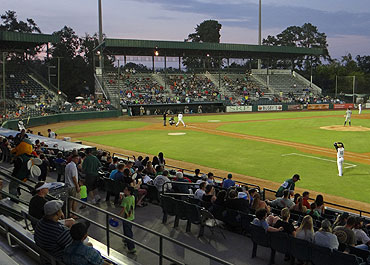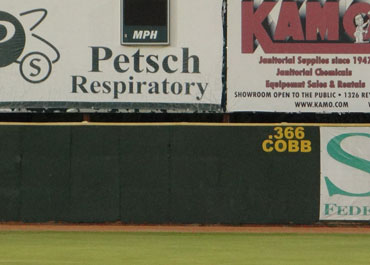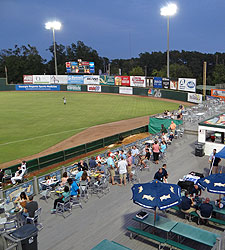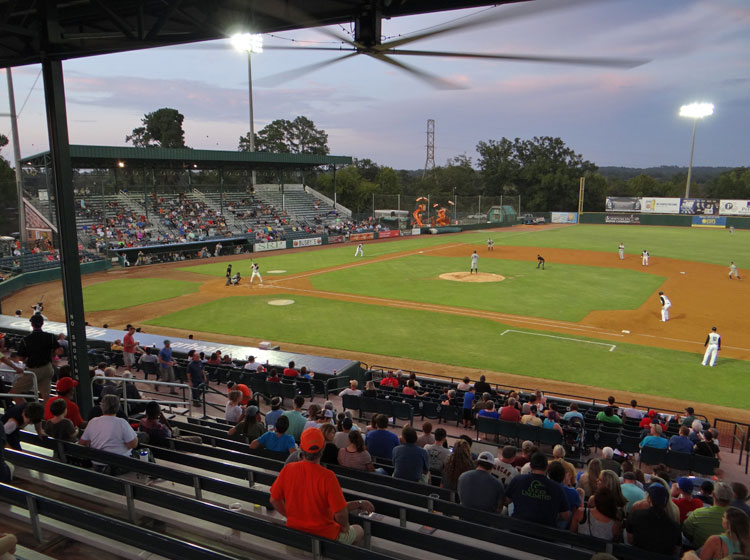
 Baseball Pilgrimages Baseball Pilgrimages
| Stadium Info |
Directions
Seating Diagram
Tickets
Phone: 706-922-9467
|
| Field Facts |
Outfield Dimensions
LF: 330' CF: 400' RF: 330'
Playing Surface
Bermuda and rye grass
Home Dugout
1st Base
|
| Numbers to Know |
|
Stadium parking: $0 (free)
Cheapest ticket: $8
(prices rise on day of game)
Ages kids get in free: 0-3
|
| Team Info |
Level: Low A
League: South Atlantic
Affiliate: San Francisco Giants
2017 GreenJackets Schedule
|
| Stadium Attendance |
| Year | Total | Average |
2016
2015
2014
2013
2012
2011
2010
2009
2008
2007
2006
2005
2004
2003
2002
2001
2000 |
169,421
174,382
169,194
176,762
182,124
200,115
201,760
194,437
200,222
177,780
155,910
123,545
159,378
131,650
127,314
140,361
136,060 |
2,606
2,725
2,525
2,851
2,846
2,943
3,011
2,902
2,902
2,614
2,475
2,025
2,415
2,123
2,122
2,127
2,093 |
| * Attendance figures listed are the regular season totals drawn by the Augusta GreenJackets at Lake Olmstead Stadium |
Baseball Pilgrimages
Where the pursuit of baseball never ends.
[Site Map]
|
|
 |
Augusta's Lake Olmstead Stadium is simply a good baseball stadium. But that's the problem, as the barometer for success these days is having a good ballpark and the home of the Augusta GreenJackets represents the difference between a baseball stadium and ballpark.
A modern ballpark, in essence, is a destination at a destination, meaning a place people flock to regardless of whether there's a game going on, and if it's a game day (or night) then people at the ballpark are often there because it is one of the places to be in an area that features some combination of dining, shopping, entertainment, trendy living quarters, etcetera in a locale that has usually been redeveloped for such a purpose. Basically, it's where a city puts its best foot forward, to use a cliché, and the ballpark is buffed up to become the chief civic point of pride in the civic point of pride.
This does not describe Lake Olmstead Stadium, which was built inexpensively in the mid-90s, in a part of the city where the armory, American Legion post and other niche drawing places aren't really destinations for the masses. While there is a nice, large serene lake very nearby it's not a part of the "ballpark" backdrop, and thus experience.
Given the limited budget (about $4 million), the end result of the stadium is quite impressive though, although it's a copycat of the modern McKechnie Field in Bradenton. That's not by accident, as it was a Pittsburgh Pirates farm team that called Lake Olmstead Stadium home at its beginning and the Pirates' spring training ballpark, which underwent an extensive redo renovation in 1993 for nearly the same cost ($3.5 million) as what was spent by Augusta shortly thereafter, served as an appropriate model.
So the three separated covered grandstands -- one behind home plate, one down the first baseline, one down the third baseline -- that make up the core stadium structure in Augusta were inspired by its Bradenton-based counterpart, right down to the style and color of roof that's above the seating. In ensuing years, both venues have added amenities to enhance their confines, and at Lake Olmstead Stadium that meant adding a large kids' play area and party deck down the outfield lines so young’uns and groups have a place to go. Otherwise, the stadium is defined by its simplicity: just those three split grandstands and the concourse behind them. Subsequently there's no open concourse encircling the field here, let alone an outfield berm or area of social congregation for the casual fan and family. Suites for corporations are absent too, no video screen is part of the scoreboard and bleachers are the most common type of seat. Stadium instead of park, indeed.
Still, there are some nice touches, as the back and sides of the stands are covered with banners detailing the teams and players of Augusta's baseball past and the memory of the Georgia Peach is alive and well here. Besides using quotes from Ty Cobb to illustrate some banners, his lifetime batting average (.366) is cleverly listed on the fence in left field (Cobb batted left-handed) where home plate is actually 366 feet away.
Such details contribute to making Lake Olmstead Stadium an eminently enjoyable venue to see a game in to me. But because this is a place where you mostly come to watch a game and go the team that plays at Augusta's stadium will soon be going...across the state line, to North Augusta, South Carolina, where a new ballpark will be built in the adjoining city on its riverfront and is anticipated to open in 2017.
So the days of pro baseball in Augusta's Lake Olmstead Stadium are numbered. When it's gone, or at least no longer used as primarily intended, it will be fair to say the stadium served its purpose well for about as long as could be expected given the circumstances. And when the GreenJackets bolt it will most likely be to a place with "park" a part of its name, as a "stadium" just isn't as homey and hospitable as is necessary in minor league baseball anymore.

Location
Lake Olmstead Stadium is next to Lake Olmstead in 114-acre Lake Olmstead Park. The lake dates to 1872 and was named for Charles Olmstead, an Erie Canal engineer who created it as part of a $371,000 project related to the Augusta Canal. Olmstead's lake and the area adjacent to it have been a source of recreation and entertainment since the late 1800s and the park, which contains a disc golf course among its modern attractions, is about two miles north of downtown Augusta.
A much more prominent place than the city's center is also about two miles from the entrance of Lake Olmstead Park, as the world famous Augusta National Golf Club, home to the Masters each April, is northwest of where the GreenJackets play. The baseball team's name was inspired by the signature Green Jacket that is bestowed upon the winner of the Masters, which is golf's only major championship to be played at the same course each year.
Alas, Augusta National is a private club that's not open to the public for tours, let alone a round of golf, although you do drive along one side of the course's perimeter when on Washington Road, which is the street that spans most of the distance between I-20 and Lake Olmstead Park. The full distance between the stadium and I-20 ramps is just 3½ miles. The stadium is just under a half-mile from the park entrance on Broad Street, where a hand-lettered Augusta GreenJackets marquee sign calls attention to where to turn onto Milledge Road.
On the 0.4 mile drive down Milledge to the stadium buildings for the American Legion and Georgia National Guard Armory are passed before Augusta's stadium is visible on the right, on the other side of the road from the lake.
And just a 3½ mile driving distance from Lake Olmstead Stadium is the site of the planned 25-acre development named Project Jackson in North Augusta, which is actually a city in South Carolina, that will soon make the stadium in Augusta, Georgia a former minor league venue. While Augusta is easily the largest city in the CSRA, the acronym for the Central Savannah River Area, come 2017 the GreenJackets will be playing on the riverfront in North Augusta, which was the result of years of failed attempts by the team to land at a new ballpark in their longtime host city. The GreenJackets' new ballpark (see a rendering here) is being designed by Odell Associates, the same architectural firm that designed BB&T Ballpark in Charlotte, which opened in 2014 and was also made for a team moving from one side of a state line to the other (the Charlotte Knights moved from Fort Mill, SC to Charlotte, NC).
Parking
There are three places you can park. The various parking lot parcels on the first base side of the stadium are a mix of paved, grass and dirt spaces. The area behind left field is a source of mostly unpaved spaces. You can also park alongside Milledge Road, which is the two-lane access road for the stadium, since it has lots of dedicated parallel parking on the side of it that overlooks the lake for which the stadium is named.
And no matter where you park, it's free to park.
 |
 |
| Three grandstands separated by gaps are the defining architectural feature of Lake Olmstead Stadium, where there are multiple tributes to Ty Cobb, baseball's best all-time hitter by average and an Augusta resident for much of his life. |
Features & Layout
The name of the stadium can't be found on the stadium itself. Nor is there a stand-alone marquee sign within eyeshot of the stadium on which its name can be posted. Instead, the only place outside of Lake Olmstead Stadium where you can see the name Lake Olmstead Stadium is on a basic civic-style street sign near its front.
The backside of the grandstands are essentially the stadium's façade, as they feature brick and ornamental steel framing. Dark green iron fencing supported by numerous brick columns form the stadium's actual perimeter. The space between the fence and stands serves as the concourse.
A three-window box office is adjacent to the stadium's entrance gates behind home plate. Rather than the stadium's name, a large Augusta GreenJackets logo is on the brick facade that's visible in the main stadium entrance area. The facade on which the team logo is posted is actually the backside of the press box, which is the only field-facing structure made of brick.
Three grandstands separated by two gaps contain the majority of the stadium's seating; 15 rows of seats are found in each. The stands are mostly covered by their own steel beam-supported roof, from which two industrial-sized ceiling fans are hung in an effort to increase airflow when the weather is warm. Seating is based on aluminum in each of the three stands. The one behind home plate has fixed seating in the form of simple one-piece molded plastic chairs, which are booster seat in style and function. The stands on the first and third base lines have rows of bleacher benches with backs in them.
The stadium's signature covered grandstands are behind a wide cross aisle. On the concrete foundation in front of the aisle are up to 6 rows of modern stadium-style seats that have attached cup holders. Fewer rows of those box seats are only found behind the dugouts. That corresponds to four of the 11 below the aisle sections, so the other seven sections have the full allotment of six rows.
 Group seating is limited, but to a large area: a wooden deck along the length of the right field line. The sizable deck has its own concession stand and lots of deck chairs and tables. Capacity is 400 on the 6,000-square-foot deck, which was a stadium add-on that debuted in 2006, when it opened with the name Budweiser Party Pavilion and at an approximate cost of $200,000.
Bullpens here have starkly contrasting surroundings. Visiting team pitchers sit and warm up in foul territory far down the left field line while the bullpen for the GreenJackets is built into the party deck that's along the right field line. Augusta's bullpen seating is next to where the first base grandstand ends and their warm up area is within the deck, where fans can sit at tables alongside one of the bullpen's sides.
A pair of pitched roof-covered structures are behind and aside the wooden deck, where they are positioned perpendicular to each other so that they have a combined L-shaped look. The building at the back of the deck has a batting cage for players under its roof while the one next to the deck is part of a courtyard area where cornhole (bean bag toss) can be played by anybody.
A large play area for kids with wood chip flooring is along the left field line, where backstop-style netting was erected to protect those using the multiple inflatables and a permanent playground from wayward line drives.
A brightly painted shed with a deck on its roof is adjacent to the foul pole just behind the right field fence. The shed itself is for grounds crew storage and usage. The deck on top of it was where those in the GreenJackets bullpen sat during the 2005 season. Prior to then, the deck was a rentable area featuring a hot tub. Now the space on the orange shed's roof goes unused.
The stadium has one scoreboard, and a very basic one at that, in right-center field. It has no video capabilities. Besides the classic runs-by-inning line score portion, the board has a bottom panel display that rotates between a player's name and stats when he's at bat. For pitchers, the speed readout of each pitched ball is posted on a MPH display that's on one of the billboards that's just behind the outfield fence in left field.
The outfield fence is wooden all the way around. It's a uniform height except where it's briefly doubled in straightaway center field to 18 feet tall to serve as the hitter's backdrop. Behind the raised batters' eye portion of the outfield wall are three flag poles.
On a portion of the outfield fence in left field is written ".366 COBB." That's a reference to the major league-record .366 career batting average of Ty Cobb, the left-handed hitting outfielder who was born, raised and died in Georgia, and began his pro career with the 1904 Augusta Tourists. Nicknamed "The Georgia Peach," Cobb was a longtime resident of Augusta and the outfield wall tribute to him is listed where the left field fence in Augusta's ballpark is 366 feet from home plate. Also, quotes from Cobb are posted on the sides of the grandstands, specifically on banners in the gaps between the stands, and his words are paired with a corresponding display that makes up the bulk of each banner.
The history of professional baseball in Augusta is well documented on the concourse, primarily on banners attached to the backsides of the grandstands. The series of banners behind the third base stands list all of the teams that have played and trained in Augusta, which was a major league spring training camp site for 19 seasons between 1902 and 1928. Banners on the backside of the first base side stands show star players, like Dustin Pedroia and Madison Bumgarner, that "made it" from Augusta since the current franchise began play in 1988. On the "Wall of Champions" beneath the player picture banners are home plate-shaped plaques touting all of the playoff teams Augusta has had in the GreenJackets franchise era. An Augusta GreenJackets Baseball Hall of Fame was begun in 2013 and write-ups of the inductees into it are on the plaques posted on the three brick pillars behind home plate, which are in front of the "The Hive," the name for the stadium's walk-in souvenir shop. Group seating is limited, but to a large area: a wooden deck along the length of the right field line. The sizable deck has its own concession stand and lots of deck chairs and tables. Capacity is 400 on the 6,000-square-foot deck, which was a stadium add-on that debuted in 2006, when it opened with the name Budweiser Party Pavilion and at an approximate cost of $200,000.
Bullpens here have starkly contrasting surroundings. Visiting team pitchers sit and warm up in foul territory far down the left field line while the bullpen for the GreenJackets is built into the party deck that's along the right field line. Augusta's bullpen seating is next to where the first base grandstand ends and their warm up area is within the deck, where fans can sit at tables alongside one of the bullpen's sides.
A pair of pitched roof-covered structures are behind and aside the wooden deck, where they are positioned perpendicular to each other so that they have a combined L-shaped look. The building at the back of the deck has a batting cage for players under its roof while the one next to the deck is part of a courtyard area where cornhole (bean bag toss) can be played by anybody.
A large play area for kids with wood chip flooring is along the left field line, where backstop-style netting was erected to protect those using the multiple inflatables and a permanent playground from wayward line drives.
A brightly painted shed with a deck on its roof is adjacent to the foul pole just behind the right field fence. The shed itself is for grounds crew storage and usage. The deck on top of it was where those in the GreenJackets bullpen sat during the 2005 season. Prior to then, the deck was a rentable area featuring a hot tub. Now the space on the orange shed's roof goes unused.
The stadium has one scoreboard, and a very basic one at that, in right-center field. It has no video capabilities. Besides the classic runs-by-inning line score portion, the board has a bottom panel display that rotates between a player's name and stats when he's at bat. For pitchers, the speed readout of each pitched ball is posted on a MPH display that's on one of the billboards that's just behind the outfield fence in left field.
The outfield fence is wooden all the way around. It's a uniform height except where it's briefly doubled in straightaway center field to 18 feet tall to serve as the hitter's backdrop. Behind the raised batters' eye portion of the outfield wall are three flag poles.
On a portion of the outfield fence in left field is written ".366 COBB." That's a reference to the major league-record .366 career batting average of Ty Cobb, the left-handed hitting outfielder who was born, raised and died in Georgia, and began his pro career with the 1904 Augusta Tourists. Nicknamed "The Georgia Peach," Cobb was a longtime resident of Augusta and the outfield wall tribute to him is listed where the left field fence in Augusta's ballpark is 366 feet from home plate. Also, quotes from Cobb are posted on the sides of the grandstands, specifically on banners in the gaps between the stands, and his words are paired with a corresponding display that makes up the bulk of each banner.
The history of professional baseball in Augusta is well documented on the concourse, primarily on banners attached to the backsides of the grandstands. The series of banners behind the third base stands list all of the teams that have played and trained in Augusta, which was a major league spring training camp site for 19 seasons between 1902 and 1928. Banners on the backside of the first base side stands show star players, like Dustin Pedroia and Madison Bumgarner, that "made it" from Augusta since the current franchise began play in 1988. On the "Wall of Champions" beneath the player picture banners are home plate-shaped plaques touting all of the playoff teams Augusta has had in the GreenJackets franchise era. An Augusta GreenJackets Baseball Hall of Fame was begun in 2013 and write-ups of the inductees into it are on the plaques posted on the three brick pillars behind home plate, which are in front of the "The Hive," the name for the stadium's walk-in souvenir shop.

|
Lake Olmstead Stadium Facts, Figures & Footnotes
Construction cost: $4.2 million
Financing: The City of Augusta and Richmond County split the cost
Architect: Bob Woodhurst (Woodhurst Architects)
General contractor: R.W. Allen and Associates
Was built on the site of Heaton Stadium, a mostly wooden and thoroughly uncovered 3,600-seat ballpark that opened in 1988 and was demolished after the 1994 season. The short lifespan of Heaton Stadium was attributed to its severe deficiencies in relation to the facility standards set forth by the 1990 Professional Baseball Agreement that had to be met by 1995 at risk of franchise revocation.
Construction began in September 1994, shortly after the minor league season ended.
Is simply named after the park it's located in, Lake Olmstead Park, although other names were strongly considered. Generically, Augusta-Richmond County Stadium was an option, given the stadium was jointly funded by the named city and county governments. Ty Cobb (player), Bill Heaton (owner) and A.L. Williams (coach) were a trio of people with ties to baseball and Augusta who were considered for the honor. But the name Lake Olmstead Stadium was officially selected on May 1, 1995, when the Augusta City Council voted to affirm the name that had been approved by the Richmond County Board of Commissioners on April 4, 1995, which was just six days before the stadium's inaugural game.
Owned by the City of Augusta.
The original lease was for 10 years and called for the GreenJackets to pay $50,000 in yearly rent. The team's rent was lowered to $25,000 per year when a new 10-year lease was agreed to in 2004.
A proposal in 2004 by commissioner Andy Cheek to name the playing field after Ty Cobb was met with resistance by the Augusta Commission, which as a whole did not want to approve the motion for the name Ty Cobb Field due to Cobb's reputation as a racist, as cited in a letter by a former president of the NAACP branch in Augusta. (It should be noted that Cobb's racist reputation was unfounded and the myth began only after his death in 1961.)
Under the guidance of Ripken Baseball, which purchased the GreenJackets after the 2005 season, numerous stadium upgrades were unveiled for the 2006 season. The wood deck down the right field line, the relocation of the Augusta bullpen within it, the big blade fans in the grandstands and the historical banners on their backside were the most notable of the improvements spearheaded by the ownership group headed by baseball legend Cal Ripken Jr., which sold the team in 2013.
The stadium's official capacity of 4,322 comes from the total number of seats in the stands. There are close to 1,000 box seats below the cross aisle and the three grandstands have approximately 3,330 seats in them. Group seating, such as what is available on the deck down the right field line, is not included in the official total but if it was then capacity for Lake Olmstead Stadium would be 4,822. That number is sometimes reported as the stadium's capacity. So to clarify the discrepancy: 4,322 is the total number of fixed seats in the stadium whereas 4,822 is what the stadium can hold if its group areas are included.
Serves as the home field for the Georgia Regents University Jaguars baseball team, which is a member of NCAA Division II.
|
|
